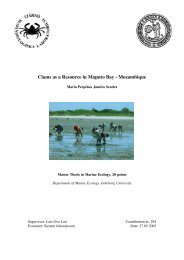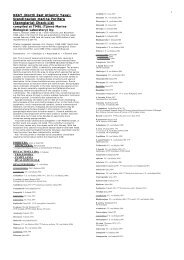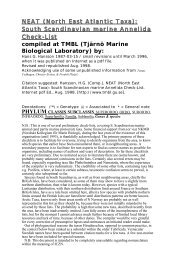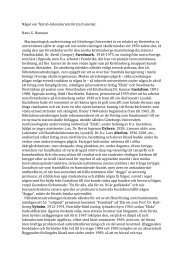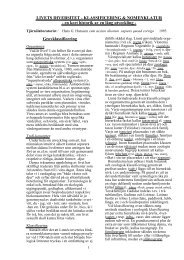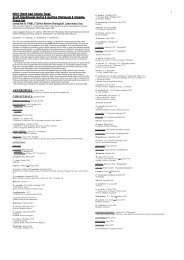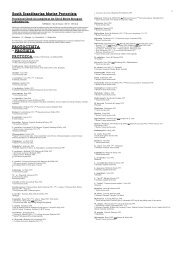Also available in -format - TMBL
Also available in -format - TMBL
Also available in -format - TMBL
You also want an ePaper? Increase the reach of your titles
YUMPU automatically turns print PDFs into web optimized ePapers that Google loves.
Zoologicheskii zhurnal 1992. 72 (11) : 128 - 132<br />
short note<br />
M, I, KISSELEVA<br />
Biological Institute of the Southern Seas, Ukra<strong>in</strong>ian Academy of Sciences,<br />
Sevastopol, Ukra<strong>in</strong>e.<br />
New genus and species of a polychaete of the Chrysopetalidae from the<br />
Black Sea.<br />
The worms were transferred to me for determ<strong>in</strong>ation by V. E Zaika, who<br />
managed to rear them from the pelagic larvae, which are always found <strong>in</strong> the<br />
central regions of the sea and earlier described as larva "B" and "C" (Kisseleva,<br />
1959), but s<strong>in</strong>ce then assumed to belong to the families Hesionidae or Dorvillidae<br />
(Kisseleva, 1990). Mur<strong>in</strong>a (1986) determ<strong>in</strong>ed these larva as Pelagiobia serrata<br />
Southern, 1909 (family Lopadorhynchidae). After metamorphosis and settl<strong>in</strong>g of<br />
the larvae on the bottom it stood clear, that they belong to the family<br />
Chrysopetalidae and form a new genus and species thereof. Until now the<br />
presence of the family Chrysopetalidae <strong>in</strong> the Black Sea has not been observed.<br />
I use the opportunity to acknowledge V. E. Zaika for giv<strong>in</strong>g me the material<br />
and G. N. Bysj<strong>in</strong>sko for consultation.<br />
Genus Victoriella gen. n.<br />
Type species: Victoriella zaikai sp. n.<br />
D i a g n o s i s : Body oblong-oval, constitutes of a lesser number (10-12) of<br />
segments. Head-rami anteriorly rounded, <strong>in</strong>serted at about the peristomial<br />
segment. Two small antennae emerge from the anterior part of the prostomium<br />
and two relatively stout palps, folded on the ventral side. Eyes not present. On<br />
the peristomium there are two pairs of tentacular cirri, situated one above the<br />
other, and biramous parapodia with dorsal and ventral cirri. The setae of these<br />
parapodia are of two types: on the dorsal ramus - simple, slightly bent, sp<strong>in</strong>y,<br />
with transverse patterns, on the ventral ramus - simple, non-sp<strong>in</strong>y, with a<br />
marked attenuation at the tip. Parapodia on the follow<strong>in</strong>g segments are<br />
biramous, with ventral and dorsal cirri, with simple, transversely striated<br />
sp<strong>in</strong>igers on the notopodia and compound heterogomph setae on the<br />
neuropodia. Proboscis barrelshaped, with teeth of platelet type. Anal ramus with<br />
two cirri.<br />
D i s c u s s i o n : The genus is close to Dysponetus Lev<strong>in</strong>sen, 1879 (family<br />
Chrysopetalidae). Nowadays there are six species known from the genus
Dysponetus (the systematical position of Chrysopetalum caecum Langerhans,<br />
1880, which was erroneously, as Laubier 1964 conv<strong>in</strong>c<strong>in</strong>gly argued, synonymized<br />
with D. pygmaeus Lev<strong>in</strong>sen, 1879, has until now not been def<strong>in</strong>ed). The<br />
description of the genus Dysponetus is characterized by numerous<br />
morphological characters, and is unified by their character of general presence of<br />
three (or more) antenna, also by the structure of their parapodia and setae. All<br />
species <strong>in</strong> the genus Dysponetus have biramous parapodia, by these notopodia<br />
with simple toothed setae (<strong>in</strong> D paleophorus Hartmann-Schröder, 1974 besides<br />
these there are a few paleae) and long dorsal cirri, situated under the setae;<br />
neuropodia - with compound heterogomph setae and dorsal cirri. Neuropodial<br />
ramus on the first segment is, as a rule, miss<strong>in</strong>g. In those cases where there is a<br />
neuropodial ramus on the first segment (D. bulbosus Hartmann-Schröder, 1982)<br />
it is without seta and ventral cirri. In the usual case the dental apparatus is of<br />
stylet type.<br />
In Victoriella the structure of parapodia and setae, beg<strong>in</strong>n<strong>in</strong>g at the second<br />
segment, are as <strong>in</strong> Dysponetus, which allows describ<strong>in</strong>g the genus to the family<br />
Chrysopetalidae.<br />
The basic characteristics of details <strong>in</strong> Victoriella that differs from all known<br />
types <strong>in</strong> the genus Dysponetus is apperarent <strong>in</strong> the structure of the peristomial<br />
segment. In Victoriella on this segment htere is besides a notopodial ramus with<br />
typical toothed, lightly bent setae with transverse striation and long dorsal cirri<br />
there is a neuropodial ramus of a well developed process type with a short<br />
acicula, a bundle of special simple setae, grow<strong>in</strong>g f<strong>in</strong>er to the distal end, and cirri,<br />
of the same length as the neuropodial process or slightly exceed<strong>in</strong>g this. More<br />
than that, Victoriella has only two short antennae and a digestive apparatus<br />
show<strong>in</strong>g small plates and not stylets.<br />
I estimate the morphological differences of the described Chrysopetalidae<br />
important enough for a differentiation <strong>in</strong> a dist<strong>in</strong>ct genus.<br />
Victoriella zaika Kisseleva, sp. n. 1<br />
M a t e r i a l : Holotype: No. 1/47370 (1 ex), Paratypes: 2/47371 (4 ex). Stored at the<br />
ZIN RAM, Sankt-Petersburg. Worms brought up from pelagical larva, collected<br />
at the 4615 station (43°29'3" N, 37°35'1" E) on 130-100 m depth, 1990-09-07, on the<br />
32nd tour of R/V "Professor Vodjanitskij".<br />
D e s c r i p t i o n : Length of the holotype is ca. 1, width 0.3 mm; number of<br />
segments 10. Prostomium <strong>in</strong>serted <strong>in</strong> the peristomial segment (fig. 1, A, B).<br />
There are, on the prostomium, two short, th<strong>in</strong> antennae, far separated from each<br />
other. On the lower side of the prostomium are two palps situated. (In liv<strong>in</strong>g<br />
1) named <strong>in</strong> honour of V. E. Zaika
Fig. 1. Victoriella zaikai: A - anterior end from dorsal side (prostomium folded), - anterior B end<br />
from ventral side, V - posterior end from dorsal side, G - setae (a - acicula, - bsimple<br />
dorsal seta, v -<br />
compound ventral seta, g - simple seta from neuropodial ramus of the peristomial segment), D -<br />
Digestive apparatus (a - left dental platlet on proborscis, b - preparation of dental platlet) (only<br />
some setae on parapodia are depicted <strong>in</strong> A, , BV).<br />
specimens the palps from time to time extend forward, situated between the<br />
antennae). Eyes not present. Peristomium consists of two fused somites. On the<br />
first of these there are two pairs of tentacular cirri ca. 0.08 and 0.06 mm <strong>in</strong> length,<br />
situated one under the other, and dorsally a bundle of simple, bent, toothed on<br />
the convex side of the setae, which are transversely banded. On the second<br />
peristomial segment there are modified parapodia. Notopododial ramus with<br />
long dorsal cirri, widened at the basal part and taper<strong>in</strong>g <strong>in</strong> the distal part, with<br />
acicula and simple, bent, toothed, transversely banded setae. Neuropodial ramus<br />
at sight a well marked process on the ventral side of the segment, with acicula, a<br />
bundle of simple setae, very attenuated at the distal end, and bottleshaped<br />
ventral cirri exceed<strong>in</strong>g <strong>in</strong> length the neuropodial process (fig. 1 B, G, g). Proboscis,<br />
extend<strong>in</strong>g ca. two segments, muscular, barrelshaped, with teeth look<strong>in</strong>g like<br />
plates, size is equal to 0.020 mm (fig 1 D, a, b). Parapodia biramous, the notopodia<br />
are noticeably shorter than the neuropodia. On both parapodial rami there are a<br />
dist<strong>in</strong>ct acicula of 0.175 mm length (fig. 1 G, a). The distal end of the notopodial<br />
acicula forms a small triangular process. A dorsal cirrus is situated at the side of
the distal end of the acicula, below the bundle of setae. It is widened at the basal<br />
part and attenuated at the distal. Length of dorsal cirri is up to 0.120 mm. Setae of<br />
the notopodia are simple, slightly bent, with teeth on the convex side and<br />
transversely banded (fig. 1 G, b). Setae are <strong>in</strong> numbers of 13-15 situated <strong>in</strong><br />
bundles, diverg<strong>in</strong>g upwards from all sides. The longest seta measures 0.137 mm.<br />
Neuropodia with ventral cirri of bottle shape and compound setae from the<br />
neuropodial ramus. On the two anterior segments the ventral cirri emerges<br />
from the base of the bundle on the neuropodial ramus, on all the follow<strong>in</strong>g<br />
segments from about the middle of neuropodia. The length of the ventral cirri is<br />
much shorter than the dorsal and is 0.50 mm. The compound setae are of the<br />
heterogomph type with delicate tooth<strong>in</strong>g and transverse patterns on the basal<br />
part. The setae are laterally positioned <strong>in</strong> the horizontal plane. Their size vary:<br />
the outer setae are shorter than the middle. The length of longest of the setae<br />
measures 0.385 mm. In the central parts of the body there are 18-20 setae <strong>in</strong> a<br />
bundle.<br />
The pygidium is surrounded on both sides by parapodial processes of the<br />
preceed<strong>in</strong>g segments (fig. 1, V). At the end of the anal ramus there are two cirri of<br />
bottle shape. Their length is equal to 0.027 mm.<br />
The location <strong>in</strong> the Black Sea of the adult is not established.<br />
N o t e s . Polychaetes of the genus Victoriella are small forms, but, obviously,<br />
the number of segments might be greater than <strong>in</strong> our specimens. We have<br />
several times noted, that <strong>in</strong>dividuals from different species, which have been<br />
brought up <strong>in</strong> laboratory conditions, are smaller than <strong>in</strong>habitants of natural<br />
populations.<br />
Fig. 2. Victoriella zaikai: A - metatrochophora (a - temporary seta)), B - old nektochaeta (b -<br />
digestive apparatus of larva).
The presence of dorsal setae on the first peristomial segment, noted <strong>in</strong> the<br />
holotype is, by all possibilities, a peculiarity of young <strong>in</strong>dividuals. In worms<br />
conta<strong>in</strong><strong>in</strong>g gametes, the dorsal setae of the first peristomial segment is absent.<br />
The generation of gametes comes from the notopodia, start<strong>in</strong>g from the sixth<br />
segment.<br />
In adult specimens of V. zaikai, there is only one pair of dental plates, while <strong>in</strong><br />
the nektochaete there are two pairs. Obviously, the second pair of plates grows<br />
<strong>in</strong>to the tissue, so that their existence is barely visible.<br />
Larvae. Metatrochophoras and nektochaetes of V. zaikai are found <strong>in</strong> the<br />
plankton of the Black Sea. Larvae are present all over the year <strong>in</strong> the central parts<br />
of the sea <strong>in</strong> the 100-150 m. layer<br />
Metatrochophora (fig. 2 A). A very widened episphere hang<strong>in</strong>g over a short,<br />
narrow<strong>in</strong>g hyposphere. The length of larva is 0.286 mm, the greatest width is<br />
0.220 mm. At the top of the episphere is a convex skullish plate with small<br />
bundles of cilia at the fr<strong>in</strong>ges. The cilia are also situated on the border between<br />
epi- and hyposphere and on the posterior end. There are to the left and right on<br />
the lower regions of the episphere rounded outgrowths carry<strong>in</strong>g bundles of<br />
simple, toothed setae, with transverse striation. (fig. 2 A, a). By irritat<strong>in</strong>g the<br />
larvae or by fixat<strong>in</strong>g them the setae diverge <strong>in</strong> all directions. The longest setae<br />
measures 0.300 mm. The larva are filled with nutritional material and looks<br />
black <strong>in</strong> transparent light. Due to the wealth of encapsulated nutritional spheres<br />
it wasn't possible to take a closer look at the <strong>in</strong>ternal structures of the larva.<br />
Nektochaeta (fig. 2 B). In the plankton one f<strong>in</strong>ds nektochaetes with three to<br />
five pairs of parapodia 0.336-0.509 mm <strong>in</strong> length. Prostomium rounded.<br />
Peristomium with one pair of tentacular cirri <strong>in</strong> young nektochaetes and with<br />
two pairs <strong>in</strong> older ones. Besides they have on the peristomial segment a bundle<br />
of simple setae on the dorsal side and compound setae on the ventral side.<br />
Young nektochaetes reta<strong>in</strong>s on the peristomium a bundle of temporary long<br />
toothed setae with transverse striation. Parapodia biramous, with short dorsal<br />
and long ventral rami. Notopodia with acicula, a bundle with simple toothed<br />
setae with transverse striation and a long dorsal cirrus, situated below the bundle<br />
of setae. Neuropodia with acicula, a bundle of compound heterogomph setae,<br />
the basal part has transverse striation, and a ventral cirrus. Proboscis<br />
barrelshaped with two pair of digestive plates (fig 2 B, b). Pygidium with two<br />
cirri. There are, <strong>in</strong> young nektochaetes, ciliated belts on the segments and on the<br />
anal ramus.<br />
The larvae are filled with nutritional spheres and look hump-backed <strong>in</strong><br />
profile.
References<br />
Kisseleva, M. I., 1959. Distribution of larvae of many-bristled worms <strong>in</strong> the<br />
plankton of the Black Sea. Trudy sevastopol'. biol. Sta. 12 :160 - 167.<br />
— 1990. On the absence of pelagic polychaete larvae <strong>in</strong> the Black Sea. Zool Zh. 69<br />
(11) : 132 - 133.<br />
Laubier, L., 1964. Contribution à la faunistique du corraligène. VI. Présence de<br />
Chrysopetalum caecum Langerhans dans l'endofaune corraligène. Vie Milieu 15<br />
(1) : 125 - 138.<br />
Mur<strong>in</strong>a, V. V., 1986. On the presence of pelagic polychaete larvae <strong>in</strong> the Black<br />
Sea. Zool Zh. 65 (10) : 1575 - 1578.<br />
(N. B. The references below are translated from Russian, check<strong>in</strong>g with<br />
Zoological Record <strong>in</strong>dicate that the correct version of the fairly recent Russian<br />
references might be).<br />
Kiselyova, M. I., 1990. On the absence of pelagic Polychaeta larvae <strong>in</strong> the Black<br />
Sea. Zoologicheskii Zhurnal. 69 (11) : 132-133.<br />
Mur<strong>in</strong>a, V. V., 1986. On f<strong>in</strong>d<strong>in</strong>g of pelagic polychaete larvae <strong>in</strong> the Black Sea.<br />
Zoologicheskii Zhurnal. 65 (10) : 1575-1579



